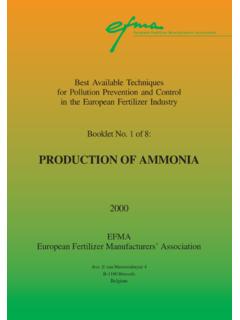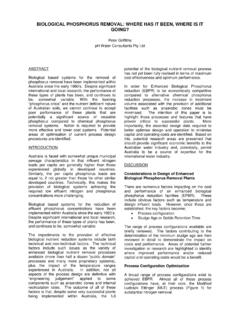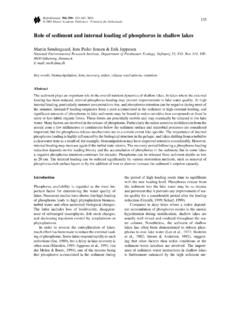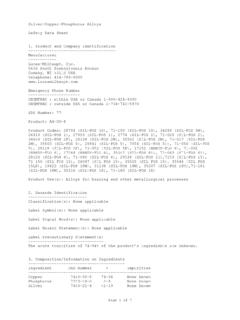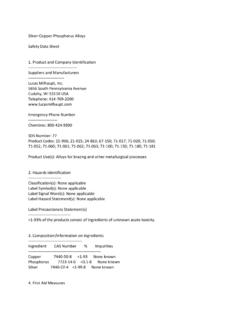Transcription of UNDERSTANDING PHOSPHORUS AND ITS USE ... - …
1 European Fertilizer Manufacturers AssociationUNDERSTANDINGPHOSPHORUSAND ITS USE JOHNSTON& I. STE Ncover 08/2000 1/02/01 17:24 Page 2In many parts of the world the landscape is managed by humankind for food production,forestry and recreation or for its beauty. For each of these uses the plants that are grown requireappropriate levels of many different nutrients. This booklet considers the essential need forphosphorus in agriculture, with a particular emphasis on PHOSPHORUS AND ITS USE IN AGRICULTURE1 European Fertilizer Manufacturers AssociationFor more information, or additional copies of this publication, please apply to theEuropean Fertilizer Manufacturers' AssociationAvenue E. van Nieuwenhuyse 4B-1160 BrusselsBelgiumTel + 32 2 675 35 50 Fax + 32 2 675 39 61E-mail 13/12/00 9:41 Page 1 PHOSPHORUS was probably discovered about 1669 by the Germanalchemist H.
2 Brandt in word PHOSPHORUS is derived from the Greek "phos" meaning"light" and "phorus" meaning "bringing".Alchemist symbol for phosphorusUNDERSTANDING PHOSPHORUS AND ITS USE IN 13/12/00 9:41 Page 2 IntroductionPhosphorus in in humans and occurrence of PHOSPHORUS in and resources of main uses of in AgricultureThe need for PHOSPHORUS in containing fertilizers in of PHOSPHORUS PHOSPHORUS more and SoilPlant nutrition, soil texture and plant root properties and texture of root PHOSPHORUS and its PHOSPHORUS value of soil PHOSPHORUS soil for readily available soil PHOSPHORUS levels and critical values for readilyavailable soil and the EnvironmentPhosphorus and some environmental sources of water and nutrients in inland and fractions of PHOSPHORUS loss from agriculture to PHOSPHORUS losses from agriculture and lake in Agriculture and the Role of the Fertilizer IndustryChanging concepts in the management of PHOSPHORUS in plant nutrient use of phosphatic PHOSPHORUS AND ITS USE IN 13/12/00 9.
3 41 Page 3 UNDERSTANDING PHOSPHORUS AND ITS USE IN AGRICULTURE4 Acknowledgements, Sources and ReferencesAcknowledgements to Amazone, BASF AG, IACR Rothamsted, International Fertilizer IndustryAssociation (IFA), Kemira Agro Oy and SKW of the European Communities (1991). Council Directive 91/271/EEC concerningUrban Waste Water of the European Communities (1991). Council Directive 91/676/EEC concerning theProtection of Waters against Pollution caused by Nitrates from Agricultural , M. C. and Saker, L. R. (1978). Nutrient supply and growth of the seminal root system inbarley. III Compensatory increases in growth of lateral roots, and rates of phosphate uptake, inresponse to a localised supply of phosphate. Journal of Experimental Botany, 29, Manual (1998).
4 United Nations Industrial Development Organization (UNIDO) and theInternational Fertilizer Development Center (IFDC). Kluwer Academic Publishers, , R. A. and Johnston, A. E. (1986). An investigation into the usefulness of phosphorusconcentrations in tissue water as indicators of the PHOSPHORUS status of field-grown spring of Agricultural Science, Cambridge, 107, 329-332. Johnston, A. E., Lane, P. W., Mattingly, and Poulton, (1986). Effects of soil andfertilizer P on yields of potatoes, sugar beet, barley and winter wheat on a sandy clay loam soil atSaxmundham, Suffolk. Journal of Agricultural Science, Cambridge, 106, , A. E., Warren, R. G. and Penny, A. (1970). The value of residues from long-periodmanuring at Rothamsted and Woburn. IV. The value to arable crops of residues accumulatedfrom superphosphates.
5 Rothamsted Experimental Station Report for 1969, Part 2, Soil Examination for Autumn Cultivations (1983). MAFF Leaflet 802. (Photographsreproduced with the permission of the Controller HMSO, London).Moss, B., Madgwick, J. and Phillips, G. (1996). A guide to the restoration of nutrient-enrichedshallow lakes, W. W. Hawes, in European Ecosystems (1999). Environmental Assessment Report No 4. EuropeanEnvironment Agency, and Potassium (P&K), No 217 (1998). CRU Publishing Ltd, in the Global Environment; Transfers, Cycles and Management (1995). ScientificCommittee on Problems of the Environment (SCOPE). Holm Tiessen (ed.), John Wiley and Sons, Loss from Soil to Water (1997). Tunney. H., Carton, , Brookes, P. C. andJohnston, (eds), CAB International, Wallingford, UK.
6 467 pp. Potash Development Association. Phosphate and Potash Removal by Crops. PDA, Brixtarw,Laugharne, Carmarthen UK SA33 4QP Scope Newsletter No. 21 (1997). Centre Europ en d'Etudes des Polyphosphates (CEEP), CEFIC, 13/12/00 9:41 Page 4 UNDERSTANDING PHOSPHORUS AND ITS USE IN AGRICULTURE5 PHOSPHORUS (P) is essential to all known lifeforms because it is a key element in manyphysiological and biochemical processes. Acomponent of every cell in all living organisms, PHOSPHORUS is indispensable and cannot bereplaced by any other element. Phosphorusoccurs in complex DNA and RNA structureswhich hold and translate genetic informationand so control all living processes in plants,animals and man. It is an essential componentof the energy transport system in all element PHOSPHORUS does not occur byitself in nature.
7 It is always combined withother elements to form can be very complex and morethan one form of phosphate will be found insoils, water, plants, animals and man. In thisbooklet, therefore, the word " PHOSPHORUS " willbe used in the text rather than identifying theparticular phosphate but, in most cases, nume-rical values will be given as P2O5( kg P2O5is equivalent kg P). PHOSPHORUS in plantsPhosphorus is essential forphotosynthesis, the process bywhich plants harvest energy fromthe sun to produce carbohydratemolecules, sugars. These aretransported to the plants storageorgans such as the root of sugarbeet or the grain of wheat, rice,maize and the potato tuberwhere the sugars are converted tostarch. This process is essential toall life, and is the first step in the chain toproduce food, feed and of DNAL ightfrom the the green substance which isfound in chloroplasts of greenleaves.
8 Chlorophyll absorbs theenergy in sunlight and uses it tocombine CO2and water toproduce sugars. Oxygen is a dioxideenters the leaf from the air and nutrientsare taken up from the PROCESS OF PHOTOSYNTHESIS- ESSENTIAL FOR LIFEP icture: IACR 13/12/00 9:41 Page 5 PHOSPHORUS is one of the primary structuralcomponents of membranes that surround plantcells. It is involved in the synthesis of proteinsand vitamins and occurs in important is taken up by plant roots from thewater in the soil, the soil solution. However, PHOSPHORUS compounds are not verysoluble, and therefore the amount of plantavailable PHOSPHORUS in the soil solution tendsto be far less than the plant requires,particularly when it is growing vigorously. Inconsequence, the PHOSPHORUS in the soilsolution may have to be replenished as oftenas ten times each day in these periods.
9 On a daily basis, a rapidly growing crop maytake up the equivalent of about kg P2O5per hectare (ha, 10,000 m2). It is clear,therefore, that there must be adequate, readilyavailable reserves of PHOSPHORUS in the unmanured soils contain too little readilyavailable PHOSPHORUS to meet the largedemand of crops, particularly during certainperiods of the growing cycle. Fertilizerscontaining PHOSPHORUS must therefore deficiency of PHOSPHORUS affects not onlyplant growth and development and crop yield,but also the quality of the fruit and theformation of seeds. Deficiency can also delaythe ripening of crops which can set back theharvest, risking the quality of the successfully produce the next generation ofplants, seeds and grains must store phosphorusso that the seedling has enough to develop itsExamples of PHOSPHORUS content in cropproducts, in grams P2O5per kg fresh (buttons) (vining) (French) of days after sowingPhosphorus uptake kg P / ha per OFP UPTAKE BY SPRING BARLEYS ource: Adapted from Leigh and Johnston uptake of PHOSPHORUS changes during crop growth.
10 Spring barley amplysupplied with PHOSPHORUS took up about kg P2O5( kg P)/ha per day(orange line) whereas a crop with little available PHOSPHORUS took up kg P2O5 ( kg P)/ha per day (blue line). Yields of grain reflected phosphorusavailability, and t/ha with and without an adequate supply of PHOSPHORUS AND ITS USE IN AGRICULTURED elayed ripening of barley (left). 13/12/00 9:42 Page 6 UNDERSTANDING PHOSPHORUS AND ITS USE IN AGRICULTURE7first roots and shoots. Then, as the rootsystem develops, the growing plant will be ableto take up the PHOSPHORUS it requires from thesoil, providing there are adequate in humans and animalsHumans and animals also need to obtain anadequate supply of PHOSPHORUS from their foodand feeding stuffs. PHOSPHORUS deficiencyaffects many of the essential processes onwhich the life of an animal depends, just as itdoes in plants.
